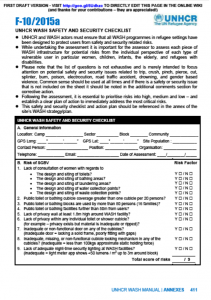
This document has been designed to help UNHCR and WASH actors assess potential WASH related safety and security issues related to trip, crush, pinch, pierce, cut, splinter, burn, poison, electrocution, road traffic accident, drowning, and gender based violence.
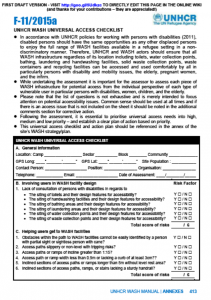
This document has been designed to help UNHCR and WASH actors assess WASH infrastructure for potential access from the individual perspective of each type of vulnerable user in particular persons with disabilities, women, children, and the elderly.
Tags: Accès pour Handicapés, Approvisionnement en Eau, Développement des Stratégies EHA, Douches, Évaluations EHA, Gestion de Programmes EHA, Installations pour la Lessive, Suivi et Evaluation EHA, Thèmes Transversaux, and Toilettes Communautaires. Languages: Anglais. Organisations: UNHCR. Categories: Directives Opérationnelles EHA, Documents de Référence EHA, Formulaires et Outils EHA, and Principes directeurs EHA.
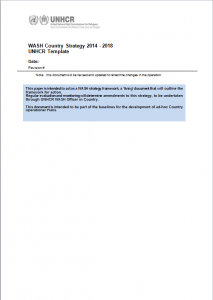
Where required, UNHCR and WASH actors should work together to develop a country level refugee WASH strategy document that clearly describes the refugee context, the baseline WASH situation, WASH coverage, WASH gaps, along with short (6 months), medium (6 months – 5 years) and long-term (>5 years) strategies for each of the WASH sub-sectors and the twelve (12) WASH principles. This template can be used to help produce the Country level WASH Strategy.
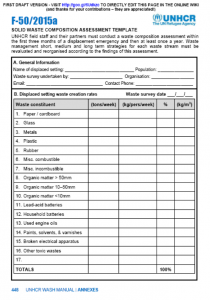
UNHCR field staff and their partners should conduct a waste composition assessment to assess the types of waste being produced and their and rates of production. Ideally the assessment should be carried out within the first three months of a displacement emergency and then at least once a year. Waste management short, medium and long term strategies for each waste stream should be revaluated and reorganised according to the findings of this assessment.
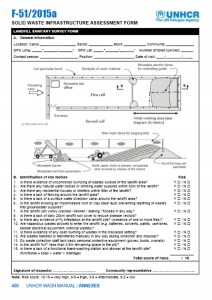
This form can be used to assess the refugee landfill site for public health and environmental sanitary risk factors.

Where required, UNHCR and WASH actors may use this template to develop a solid waste management action plan that describes a list of prioritised solid waste management activities in addition to WHO, WHAT, WHERE, WHEN and HOW they will be carried out.
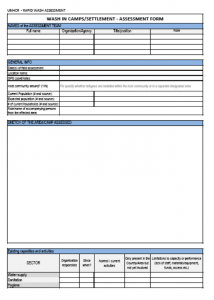
These rapid (emergency) assessment tools can be used to help assess water supply, excreta management, solid waste management, hygiene and disease vector control conditions in the following refugee settings: These rapid (emergency) assessment tools can be used to help assess water supply, excreta management, solid waste management, hygiene and disease vector control conditions in the following refugee settings: Camps; Settlements; Transit Centres; Schools; Health Centres and Urban Settlements. It also contains references to UNHCR’s WASH indicators and recommendations for data collection.
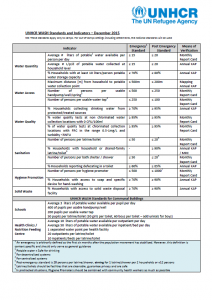
A summary of UNHCR water, excreta management, solid waste management, disease vector control and hygiene promotion standards and indicators for emergency and post emergency refugee settings including means of verification.
Tags: Approvisionnement en Eau, Contrôle et Suivi de la Qualité de l'Eau, Développement des Stratégies EHA, Douches, Écoulement des Eaux, Évaluations EHA, Gestion des Déchets Solides, Gestion des Excréta, Lavage des Mains au Savon, Lutte Antivectorielle, Sensibilisation à l'Hygiène, and Suivi et Evaluation EHA. Languages: Anglais. Organisations: UNHCR. Categories: Normes et Indicateurs EHA.
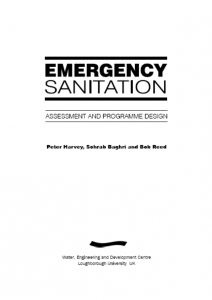
The book Emergency Sanitation: Assessment and programme design has been produced to assist those involved in planning and implementing emergency sanitation programmes. The main focus of the book is a systematic and structured approach to assessment and programme design. It provides a balance between the hardware (technical) and software (socio-cultural, institutional) aspects of sanitation programmes, and links short-term emergency response to long-term sustainability. The book is relevant to a wide range of emergency situations, including both natural and conflict-induced disasters, and open and closed settings. It is suitable for field technicians, engineers and hygiene promoters, as well as staff at agency headquarters.
Tags: Compostage des Excréta, Égouts et Acheminement des Excréta, Évaluations EHA, Gestion de Programmes EHA, Gestion des Excréta, Réutilisation des Excréta / Urine, Suivi et Evaluation EHA, Toilettes Communautaires, Toilettes Familiales, Traitement des Excréments, and Vidange et Transport d'Excréta. Languages: Anglais. Organisations: WEDC. Categories: Directives d'Urgence EHA and Documents de Référence EHA.
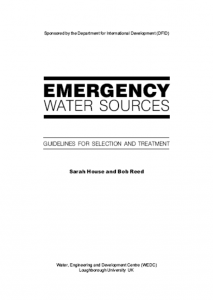
These guidelines have been designed to help those involved in the assessment of emergency water sources to collect relevant information in a systematic way, to use this information to select a source or sources and to determine the appropriate level of treatment required to make the water suitable for drinking.
Tags: Approvisionnement en Eau, Camions Citerne, Collecte des Eaux de Pluie, Contrôle et Suivi de la Qualité de l'Eau, Eaux Souterraines, Évaluations EHA, Forages, Gestion de Programmes EHA, Plans pour la Sécurité en Eau, Pompage d'Eau, Pompe Manuelle, Prospection d'Eau, Protection des Sources, Puits Creusés à la Main, Puits Forés, Réseaux d'Adduction d'Eau, Stockage de l'Eau, Suivi et Evaluation EHA, Traitement de l'Eau, and Traitement de l'Eau au Ménage. Languages: Anglais. Organisations: WEDC. Categories: Directives d'Urgence EHA and Documents de Référence EHA.
 Français
Français










